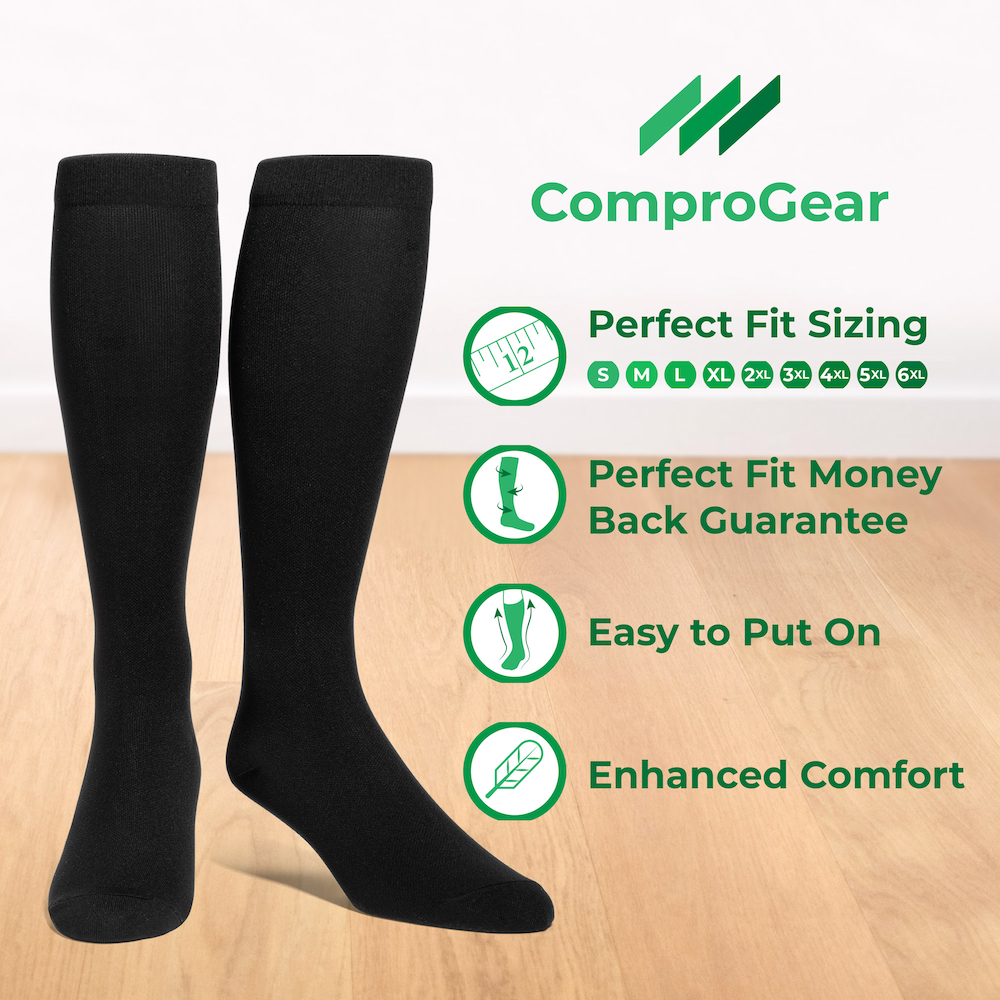No More Dealing with Swollen, Achy Feet and Ankles when Pregnant
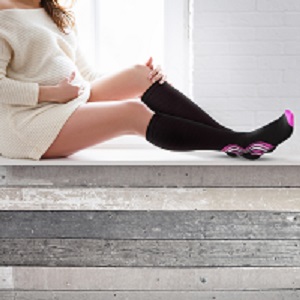
The changes your body goes through during pregnancy can be extremely discomforting.
Body changes range from an expanding uterus and weight gain to more serious hormonal changes. One of the worst changes is having lower legs that are swollen and achy. You go through the day looking like a tree trunk wondering what you signed up for by getting pregnant and if things will ever get better. While these changes are normal, they are still uncomfortable and painful. That is why maternity compression socks are all the rage for pregnant women.
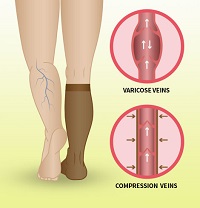
Usually, the degree of discomfort that is experienced depends on what you have done to lessen the pain. Swollen feet and ankles can persist throughout your pregnancy making it difficult and sometimes painful to walk but with the right product (maternity compression socks) and by wearing them quickly, there should be nothing to worry about. Do not, however, ignore this natural condition because it may interfere with your well-being and even trigger the development of serious conditions like blood clot formation.
Maternity compression socks have been proven to be the best in swelling reduction and pain management on ankles and feet. With all the responsibilities that come with pregnancy, nothing is better than having a solution to this problem. It is quite an easy and effective answer to such an overwhelming problem. Its functionality seems too good to be true, but its benefits have been proven. Without the research backing the socks’ usefulness, it would be impossible for many to believe that these socks would solve pregnant women’s leg pain.
Maternity compression socks provide exceptional comfort during your pregnancy. Aside from helping you get through the toughest period of your pregnancy, compression socks will also improve your circulation enabling your growing baby to receive more nutrients and your body to be in its best form. The socks do not modify any part of your body permanently. They only function as a cushion in reducing excessive swelling and improving blood flow from your feet and legs to your heart.
What Maternity Compression Socks Help With
You will have to endure big changes in your body during pregnancy:
Blood Volume and Flow Issues Caused by Pregnancy
There are two ways blood volume and blood flow affects the health of your ankle and feet.
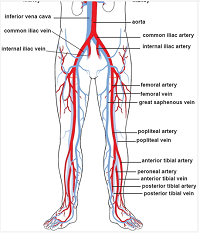
Blood Influx and Efflux Complications
Your blood volume increases by up to 50% during pregnancy. A large volume of this blood flows to your uterus to nourish the fetus with nutrients and oxygen and to remove metabolic wastes. However, despite the influx of this blood in your womb, there is decreased blood flow from your legs to the pelvic region.
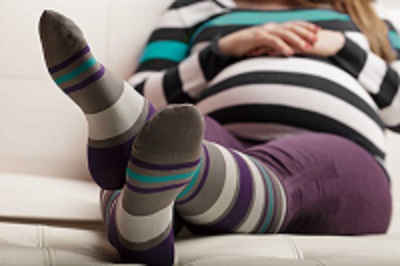
Obstruction from the Growing Uterus
In addition to this, the expanding uterus adds pressure to the vena cava, the vein that transports blood from the feet and legs to the heart, slowing down the blood flow rate. These changes are completely normal and change soon after pregnancy.

Ordinarily, pumping blood from the legs and feet to the heart is a complicated affair. During pregnancy, the result is swollen feet and ankles, vein inflammation and (on some occasions) the formation of blood clots. It is worth noting that blood clots primarily develop because of a lack of movement or sitting for long periods of time during pregnancy. It is such a relief knowing maternity compression socks can prevent such a serious condition.
Still, when the reduced blood volume is left untreated it may trigger the formation of clots due to the strain of getting blood back to the heart. Regardless of these conditions, the might of the maternity compression hosiery can prevent and assuage these conditions.
Pregnancy Triggered Edema
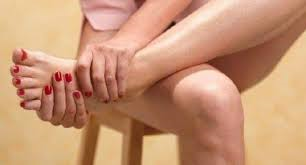
Aside from blood volume increase, swollen feet and ankles can also be a result of increased fluid retention during pregnancy; a condition known as edema. The purpose of the retention is to soften your body to ease the process of expansion. The extra fluid softens your muscles and tendons enabling them to remain intact as your body stretches. Body enlargement not only makes room for the growing fetus but also accommodates other bodily changes. The ankles and feet fall victim to fluid retention because of gravity which causes the fluids to percolate downward on your lower feet. Luckily for you, maternity compression socks can also handle edema as well.
Other Factors that Aggravate Swelling and Achy Feet
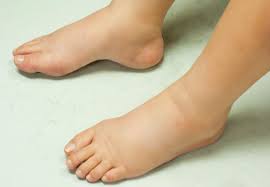
Some of your behaviors and occupations can also cause your feet to swell and hurt when you are pregnant. Standing and sitting for long periods, low potassium levels, high sodium dietary intake, high heat levels (particularly during the hotter months of the year) and consuming too much caffeine are the main culprits behind swollen feet aside from biology.

While watching what you eat and regulating activities such as standing and sitting periods are quintessential to reducing leg and ankle swelling during pregnancy, wearing maternity compression socks comes in handy especially when meals and activities are unavoidable. The socks not only reduce swelling but also improve blood circulation. It ‘s recommended to use compression socks in conjunction with other healthy resolutions to reduce or prevent swelling and aches in your lower extremities.
How Do These Socks Work?

Compression Sock Action on the Veins
Maternity compression socks prevent and reduce swelling on your legs and feet. The socks affect the vein return part of the circulation. Simply put, there are two main types of blood transportation systems in the body: arteries and veins.
- Arteries are responsible for pumping blood from the heart to the rest of the body including the legs and ankles.
- Veins, on the other hand, pump blood from the body back to the heart.
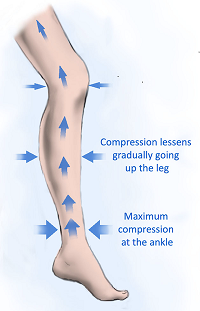
Maternity compression socks work on the veins which return the blood back to the heart; hence the name vein return. The compression socks constrict the diameter of the veins (which are usually distended), in effect, increasing blood flow velocity from the lower extremities to the heart. By raising the blood flow rate, compression stockings enable a healthy circulation from your ankles and legs to the heart.

The snug-fitting maternity compression socks are made from an elastic material which puts more pressure on the ankle than the calf. The compression sock material wraps around the muscles, tendons, ligaments, ankles, and calves; this, in turn, prevents the pooling of blood from the legs (the main culprit behind the ankle and leg swelling), blood clots and varicose veins during pregnancy. The compression degree is most at the bottom of the leg and least on top. These socks put more pressure on your ankles making it easy for the blood to flow upward to your heart.
Benefits of Compression Socks on Edema
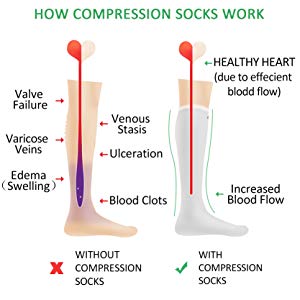
As for edema, maternity compression socks squeeze the ankles, feet and the lower legs preventing the accumulation of fluid in the tissues within these areas. So during pregnancy, you will have painless and normal-sized ankles and legs.
Understanding the Three Standard Compression Ratings
Maternity compression socks come in a variety of levels or ratings. The levels indicate how much compression the socks offer. The levels are usually calibrated in mmHg (read as millimeters of mercury). The unit is a measure of pressure (including blood pressure). A compression level of 20-30mmHg indicates that the socks will not go beyond 20mmHg or above 30mmHg. The lower number in the unit shows the compression level at the top of the compression sock while the higher number represents the compression level at the ankle region of the sock.
Standard Compression Ratings
There are three standard levels of compression socks: the 15-20mmHg, 20-30mmHg and 30-40mmHg. The levels relieve lower leg swelling and ache in varying degrees.
The 15-20mmHg Compression Socks
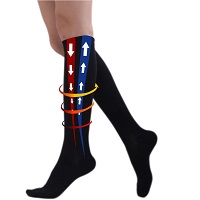
The 15-20mmHg compression rating, for instance, is essential for mild swelling or leg fatigue. Individuals who stand up or sit down for long hours can find great relief from this level of compression socks.
The 20-30mmHg Compression Socks
Pregnant mothers, on the other hand, can use the 20-30mmHg maternity compression socks; this compression rating belongs to the first medical-grade compression because it works on the veins without overwhelming the legs. They are most suitable for you because they fix heaviness, distension, and pain.
The 20-30mmHg maternity compression socks will also provide comfort for patients suffering from varicose veins and spider veins. They are not as light as the 15-20mmHg compression socks and will accommodate your condition from the onset of lower leg swelling and aches to the end of the pregnancy period when the condition permanently subsides.
The 30-40mmHg Compression Socks
The 30-40mmHg compression socks belong to a higher medical-grade; this compression rating is suitable for people suffering from moderate to acute leg pressure complications. It is used to manage conditions such as deep vein thrombosis, blood clots or lymphedema. Maternity compression socks in this level of compression must be prescribed by a doctor.
For pregnant women suffering from normal ankle and leg swellings and aches, the 20-30mmHg maternity compression socks will suffice. It is vital that you consult your doctor before purchasing maternity compression hosiery to ascertain your condition and the level of compression suitable for you.
Compression Socks and Quality
Once you know the compression rating for your socks, you will need to purchase long-lasting maternity compression socks. It is important to consider the quality of compression support prior to making a purchase because there are a plethora of brands that produce compression socks in the market and some are lacking in quality.
Here are some tips for spotting quality compression socks.
Quality in Sock Usability

The first thing to consider in regard to quality when purchasing maternity compression socks is usability because of the frequency and duration of use. Swelling on the feet and legs may begin early during pregnancy or from the fifth or seventh month. Regardless of its start, it will persist until the end of your pregnancy. Furthermore, the magnitude of swelling usually worsens in the third trimester. Other than this, the compression socks will be your daily companion throughout each day; in the morning after you get out of bed until you retire back to bed at night. You will, therefore, need quality socks that can withstand the frequency and duration of use. Ineffective socks at the peak of your pregnancy will not be useful in the long run.
Sock Material and Quality
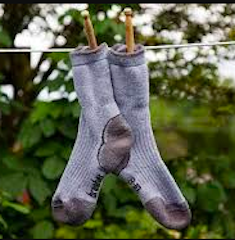
You should also consider the material used to make your maternity compression socks to see its functionality and durability before you commit to buy. High standard compression socks are made of a superior material that does not lose elasticity and functionality throughout the pregnancy period-even with frequent washing. Polyester and nylon make the best combination. Both materials are flexible and excellently wrap around the feet, ankles, calves, and knee caps. Nylon is also a terrific moisture absorber that remains durable with every subsequent wash. It also maintains the pliancy of the socks.
The Graduated Compression Factor
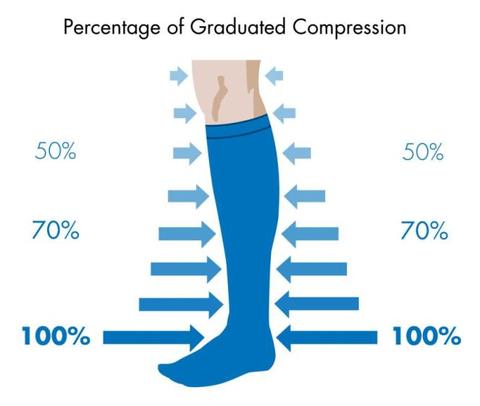
Another important quality to consider is the graduated compression factor. The best maternity compression socks will have a greater compression level at the ankle. The degree of compression will also decrease as you move up the sock. The degree of compression varies to help push your blood from the ankle to the top of your leg efficiently. Without this feature, the sock will not help with blood circulation. Well -designed socks will have different degrees of compression throughout the sock length because it is integral to its purpose of use.
Finding Comfort in Compression Socks
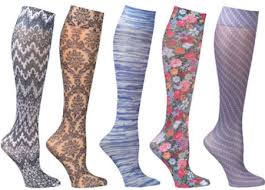
Compression socks are designed to give you comfort during your pregnancy; they should relieve your pain and ease the swelling on your ankles and legs. The socks should be easy to put on and take off because the strain in your third trimester may hinder your resolve to wear and remove these socks. Therefore, having the comfort of easy dressing is a benefit.
You will want to buy from brands that specialize in maternity compression socks or have a line specifically for pregnant mothers because they will be sure to incorporate features that favor your body and ease the dressing process for you. These features and functionalities can only be guaranteed in good quality socks.
Length Factor and Compression Socks
Aside from pressure levels, maternity compression hosiery have different lengths. You can choose the length of the socks depending on your area of need.

- Knee-high compression socks, for instance, soothe the ankle and calf region.
- Thigh-high compression socks work on the thighs in addition to the ankle and calves.
- On the other hand, full-length pantyhose provides relief on the entire leg, thighs and alleviates back pain as well.
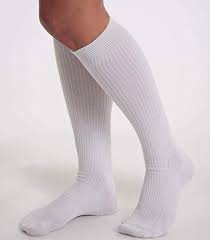
It is a fallacy to assume that longer socks provide more comfort. Each length comes with its advantages and/or disadvantages. The thigh-high and full-length pantyhose may alleviate discomfort in more regions than the knee-high maternity compression socks, but they are also difficult to put on and to remove. Bear in mind that the socks come in handy when you are heavily pregnant – in your third trimester. It is safe to say the longer the compression sock the harder it is to wear.
Based on this understanding it is better to have knee-high socks.
Compression Socks and Cuteness Appeal
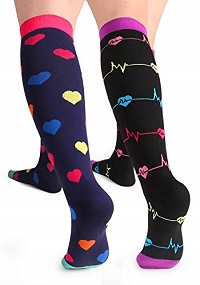
Aesthetics is everything. Your maternity compression socks are going to be part of your everyday wear for over three months. You will put them on every day as part of your attire; therefore, they might as well be cute and appealing, at least to you, considering the tumultuous task of carrying another human being and the complications it brings. Having dull compression socks can dampen your mood a little. Liven up the occasion with colored socks, especially those with exhilarating hues or colors reflecting your desires to increase the needed fortitude to push through another day.
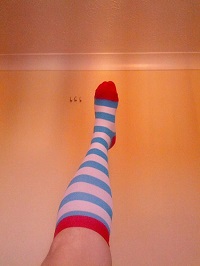
Besides, who said you should not look cute while fighting the horrors of swollen ankles and feet? Enjoy the bright and lovely patterned maternity compression socks with floral or polka dots all over. Let the compression socks be a reminder that there is light at the end of the tunnel (and no, it is not an oncoming train) with adorable socks to restore your feet from the swelling and pain debacle. Warm or cool colors can put an end to your depression and make you feel lively despite the condition. It may not seem like much, but it will boost your mood when it also performs meticulously.
Cheers to a Smooth Healthy Pregnancy thanks to Compression Socks

You deserve that pat on the back for remaining resilient and determined on your pregnancy journey. It is not an easy process to accommodate and acclimatize. In many ways, your pregnancy journey is a good indicator that you are stronger than you credit yourself. Although the difficulties of pregnancy have been made abundantly clear, sunny days are also present; it is not always doom and gloom. With little helpers like the maternity compression support hose, even rainy days come with the much-needed rainbow effect cheering you on; so, persevere.
Moreover, it is comforting to know that pregnancy body transformations are essential for you and your growing baby’s health and well-being. Where nature falls short or offers a harsh alternative, science has swooped in to maintain harmony and preserve the sanctity of life. That is why it is no longer necessary to stress over swollen ankles and feet or worry about developing clots. With maternity compression socks, you can travel without fear if the circumstances warrant it without developing complications and do so much more.
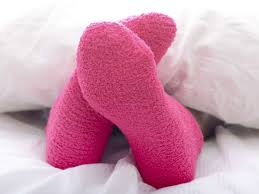
With all this knowledge, you can now make an informed decision on purchasing cute and comfortable maternity compression socks. You will be able to breeze through your pregnancy. You will be able to carry your child to term without the fear of developing clots or spider veins. Remember to put the compression socks on as soon as you wake up and remove them before going back to bed. The socks will provide relief for your condition that you need while giving you a reason for thanksgiving as you go on your journey.
